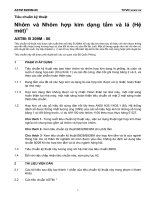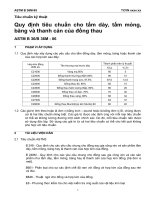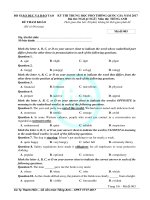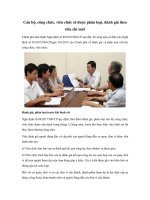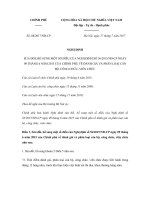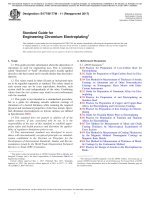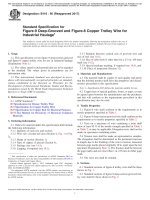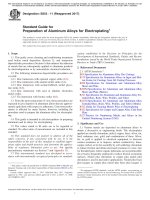Astm b 480 88 (2017)
Bạn đang xem bản rút gọn của tài liệu. Xem và tải ngay bản đầy đủ của tài liệu tại đây (83.18 KB, 3 trang )
This international standard was developed in accordance with internationally recognized principles on standardization established in the Decision on Principles for the
Development of International Standards, Guides and Recommendations issued by the World Trade Organization Technical Barriers to Trade (TBT) Committee.
Designation: B480 − 88 (Reapproved 2017)
Standard Guide for
Preparation of Magnesium and Magnesium Alloys for
Electroplating1
This standard is issued under the fixed designation B480; the number immediately following the designation indicates the year of
original adoption or, in the case of revision, the year of last revision. A number in parentheses indicates the year of last reapproval. A
superscript epsilon (´) indicates an editorial change since the last revision or reapproval.
a naturally occurring oxide film, usual procedures for the
preparation of metals for autocatalytic or electrolytic plating
cannot be used.
1. Scope
1.1 This guide describes two processes used for plating on
magnesium and magnesium alloys: direct electroless nickel
plating and zinc immersion. Some users report that the direct
electroless nickel procedure does not produce quite as high a
level of adhesion as zinc immersion.
4. Reagents
4.1 Purity of Reagents—All acids and chemicals used in this
guide are of technical grade. Acid and base solutions are based
on the following assay materials:
1.2 The values stated in SI units are to be regarded as
standard. No other units of measurement are included in this
standard.
1.3 This standard does not purport to address all of the
safety concerns, if any, associated with its use. It is the
responsibility of the user of this standard to establish appropriate safety and health practices and determine the applicability of regulatory limitations prior to use. For specific hazard
statements, see 5.1.1 and 5.2.9.2.
1.4 This international standard was developed in accordance with internationally recognized principles on standardization established in the Decision on Principles for the
Development of International Standards, Guides and Recommendations issued by the World Trade Organization Technical
Barriers to Trade (TBT) Committee.
Ammonium hydroxide (NH4OH)
Nitric acid (HNO3)
Sulfuric acid (H2SO4)
Hydrofluoric acid (HF)
Phosphoric acid (H3PO4)
30
67
93
70
85
mass
mass
mass
mass
mass
%,
%,
%,
%,
%,
density
density
density
density
density
0.895 g/L
1.16 g/L
1.40 g/L
1.258 g/L
1.689 g/L
4.2 Purity of Water—All water used for solutions, whether
new or recycled, should be monitored for cations, anions, and
organic matter that are known to interfere with the plating
process.
5. Processes
5.1 Procedures:
5.1.1 Wheel polish and buff parts for smooth, highly polished surfaces. Tumble and burnish small parts. Acid pickle the
parts after use of wire brushing or steel wool. (Warning—
Because of the high flammability of powdered magnesium,
special precautions against fire are important. Polishing and
buffing lathes should be kept scrupulously clean. Dust from
grinding in and around lathes should be swept up and placed in
closed containers for proper disposal. Exhaust systems should
be cleaned frequently and the residues handled similarly. If
abrasives are used in tumble finishing, similar precautionary
techniques should be used for the solids from the abrasive
slurry.)
5.1.2 Chemical—Remove oil and grease in an alkaline soak
cleaner. Remove other soils and coatings in suitable acid
pickling solutions.
2. Referenced Documents
2.1 ASTM Standards:2
B322 Guide for Cleaning Metals Prior to Electroplating
3. Significance and Use
3.1 Metals are electroplated on magnesium for various
purposes: solderability, RF grounding, hermetic sealing, wear
resistance, corrosion resistance, appearance, and electrical
conductivity, for example. Because magnesium is covered with
1
This guide is under the jurisdiction of ASTM Committee B08 on Metallic and
Inorganic Coatings and is the direct responsibility of Subcommittee B08.02 on Pre
Treatment.
Current edition approved May 1, 2017. Published May 2017. Originally
approved in 1968. Last previous edition approved in 2010 as B480 – 88(2010). DOI:
10.1520/B0480-88R17.
2
For referenced ASTM standards, visit the ASTM website, www.astm.org, or
contact ASTM Customer Service at For Annual Book of ASTM
Standards volume information, refer to the standard’s Document Summary page on
the ASTM website.
NOTE 1—General information on the cleaning of metals is given in
Practice B322.
5.2 General Electroplating Procedure:
5.2.1 Remove oil, grease, and other soils left from preplating procedures by soak cleaning in an alkaline cleaner suitable
for magnesium.
5.2.2 Rinse in cold water.
Copyright © ASTM International, 100 Barr Harbor Drive, PO Box C700, West Conshohocken, PA 19428-2959. United States
1
B480 − 88 (2017)
fiberglass equipment of any kind. Careful control is essential
for best results. Maintain the pH between 10.2 and 10.4
electrometric (glass electrode) measured at 25°C. (Warning—
The glass electrode must be used with caution. Do not allow
the electrode to remain in contact with the zincate solution for
prolonged periods. Inspect and test the electrode regularly to
ensure that no change has occurred from contact with fluoride
ion. Colorimetric (paper) methods may be used. However, the
colorimetric readings may vary 60.5 pH units.)
5.2.10 Rinse thoroughly in cold water.
NOTE 2—As generally used in rinsing terminology, cold water refers to
water from an unheated water supply as opposed to heated water used for
drying or other purposes. In some areas, particularly in water, ambient
water temperatures may be too low for effective rinsing. In those
instances, the rinse water may need to be heated. A minimum temperature
of 16°C is recommended for effective rinsing.
5.2.3 Electroclean parts in an alkaline electrocleaner suitable for magnesium. Make the magnesium cathodic at 7.5 to 13
A/dm 2 and 85°C.
5.2.4 Rinse in cold water.
5.2.5 Pickle in one of the following solutions:
5.2.5.1 Ferric Nitrate Pickle:3
Chromic acid (CrO3)
Ferric nitrate (Fe(NO3)·9H2O)
Potassium fluoride (KF)
Temperature
Time
NOTE 6—For alloys M1660, M13120, M13312, or M13310, a double
zinc immersion is required. After step 5.2.10, steps 5.2.7 – 5.2.10 are
repeated followed by step 5.2.11. It is advisable to use separate solutions
for steps 5.2.7 and 5.2.9 when the double zinc immersion technique is
practiced.
180 g/L
40 g/L
3.5 g/L
16 to 38°C
15 s to 3 min
5.2.11 Copper strike in either of the following:
NOTE 3—This pickle removes metal from a surface at the rate of 3
µm/min at 38°C. Where no dimensional change can be tolerated, use of the
chromic acid pickle in 5.2.5.2 is recommended.
Bath 1:
Copper cyanide (CuCN)
Potassium cyanide (KCN)
Potassium fluoride (KF)
Free potassium cyanide
pH
Temperature
5.2.5.2 Chromic Acid Pickle:3
Chromic acid (CrO3)
Temperature
Time
180 g/L
16 to 93°C
2 to 10 min
NOTE 4—The use of chromic acid pickles may leave chromate films on
the surface that will reduce the adhesion of the subsequently deposited
coating.
Bath 2:
Copper cyanide (CuCN)
Sodium cyanide (NaCN)
Rochelle salt (KNaC4H4O6·4H2O)
Free sodium cyanide
pH
Temperature
5.2.6 Rinse in cold water.
5.2.7 Activate in the following solution:3
Phosphoric acid, (H3PO4)
Ammonium bifluoride (NH4HF2)
Temperature
Time
20 % by vol
105 g/L
16 to 38°C
15 s to 2 min
30
120
5
2
5
g/L
g/L
g/L or
g/L
g/L
5.2.9.1 Because of the low solubility of the tetrasodium
pyrophosphate, it is generally necessary to mix this solution in
an elevated temperature from 70 to 85°C. It is also advantageous to alternately add portions of the zinc sulfate and
pyrophosphate. When these ingredients are completely
dissolved, add and dissolve the balance of the ingredients in the
order given.
NOTE 5—Either sodium fluoride or lithium fluoride may be used as a
constituent of this bath. Sodium fluoride is widely used, but requires
careful control. Potassium fluoride is too hygroscopic and should not be
used because the variation in water content makes it impossible to be sure
of how much is being added. Lithium fluoride has been found highly
desirable because it is soluble only to the proper concentration level and
is self-regulating. Thus, the use of lithium fluoride eliminates the need for
fluoride analysis. During bath makeup, 3 g/L lithium fluoride is added.
This small quantity saturates the solution, and an excess suspended in the
bath in a canvas or nylon anode bag automatically replaces any fluoride
consumed during the operation.
Etch 1—For Alloys Containing Aluminum:3
Chromic acid (CrO3)
120 g/L
Nitric acid (HNO3)
(11 % by vol nitric acid + 89 % by vol water) to make 1L
Etch 2—For Other Magnesium Alloys:3
Chromic acid (CrO3)
60 g/L
Nitric acid (HNO3)
(9 % by vol nitric acid + 91 % by vol water) to make 1 L
Stainless steel tank or tank lined with glass, ceramic, polyvinyl chloride, polyethlene, or other suitably resistant plastic material.
5.2.9.2 Immerse the parts for 3 to 10 min in the solution
operated at 79 to 85°C and agitate mildly. Do not use glass or
3
38 to 42 g/L
50 to 55 g/L
40 to 48 g/L
7 to 8 g/L
9.6 to 10.4
54 to 60°C
5.2.11.1 Plate the parts about 6 min. Cathode rod agitation is
suggested. With either bath make electrical contact quickly
with initial current 5 to 10 A/dm2, then lower current to 1 to 2.5
A/dm2.
5.2.12 Rinse thoroughly in cold water.
5.2.13 Dip in diluted acid (1 % by vol sulfuric acid + 99 %
by vol water).
5.2.14 Rinse in cold water.
5.2.15 Apply subsequent electrodeposits or autocatalytic
nickel in accordance with standard commercial electroplating
practice.3 Use plastisol-coated racks that are fitted with stainless steel or phosphor-bronze rack tips.
5.3 Autocatalytic Nickel Plating Magnesium:
5.3.1 Surface Conditioning—See 5.1.1 and 5.1.2, and 5.2.1
– 5.2.4.
5.3.2 Pickling—Pickle in (1) chromic acid3 as directed in
5.2.5.2 or in (2) phosphoric acid3 (90 % by vol phosphoric
acid + 10 % by vol water) using a lead, glass, ceramic, or
rubber-lined tank of polyethylene, polypropylene, or other
suitably corrosion resistant material.
5.3.3 Rinse in cold water.
5.3.4 Chemical etch in one of the following:
5.2.8 Rinse in cold water.
5.2.9 Zinc coat in the following solution:
Zinc sulfate (ZnSO4·H2O)
Tetrasodium pyrophosphate (Na4P2O7)
Sodium fluoride (NaF) or
Lithium fluoride (LiF)
Sodium carbonate (Na2CO3 )
38 to 42 g/L
64.5 to 71.5 g/L
28.5 to 31.5 g/L
7 to 8 g/L
9.6 to 10.4
54 to 60°C
Magnesium Finishing, The Dow Metal Products Co., Midland, MI.
2
B480 − 88 (2017)
Immerse parts 20 to 60 s in solution at room temperature.
Rinse thoroughly and proceed immediately to hydrofluoric acid
dip.
Use a tank lined with polyvinyl chloride plastisol, bakedphenolic based enamels, polyethylene, polypropylene, or other
suitably resistant material. Use mild mechanical agitation.
Immerse parts in nickel solution operated at 77 to 82°C with a
pH range of 5.5 to 6.3, measured at 25°C. The bath should be
filtered either periodically or continuously. The use of a pump
which is sealess or designed for operation in fluoride and with
electroless nickel solution is recommended. To ensure adequate
filtration, the solution should be filtered in excess of 20 tank
volumes per hour through a 5-micron filter. The use of a
plastic, magnetically coupled pump will eliminate problems
with shaft seals.
NOTE 7—Use the chromic acid pickle where dimensional change cannot
be tolerated. Do not use on alloys containing thorium. For thoriumcontaining alloys and on other alloys where dimensional change is not
critical, use phosphoric acid pickle. Immerse parts 30 s to 1 min in the
phosphoric acid pickle at 21 to 32°C. Metal loss is about 13 µm/surface.
If thorium alloys have critical dimensions, use chromic acid pickle and
follow with an immersion in a strongly alkaline cleaner to remove possible
chromate films.
5.3.5 Dip3 in hydrofluoric acid (5.5 vol % hydrofluoric
acid + 94.5 vol % water) using a tank lined with polyvinyl
chloride, polyethylene, or polypropylene. Immerse parts 10
min in solution at room temperature. For treating M11610 or
M11800 use a 20 vol % hydrofluoric acid + 80 vol % water
solution. Transfer to nickel bath immediately after rinsing. Use
of ammonium bifluoride (NH4HF2), at 60 to 90 g/L (8 to 12
oz/gal) can often be substituted for hydrofluoric acid. Use of
ammonium bifluoride eliminates the hazard of handling concentrated hydrofluoric acid.
NOTE 9—If heavy electroless nickel deposits are to be applied, the parts
can be transferred to the appropriate bath after a thickness of 5 µm has
been deposited from this bath.
5.3.7 Rinse in cold water. For maximum corrosion resistance when the above plate is the final deposit, immerse for 10
min in (1) chromic acid (CrO3)5 (2.5 g/L) or (2) sodium
dichromate (Na2Cr2O7·2H2O) (120 g/L). Operate both solutions at 88 to 100°C. Proprietary compounds are available
which operate at room temperature.
5.3.8 Thoroughly rinse in cold water and dry. To improve
adhesion, bake at 200°C for 1 h. The deposit should remain
adherent and free of blisters.
NOTE 8—The zinc immersion coating plus copper strike can be used
instead of chemical etching (see Section 1). Follow steps 5.2.5 – 5.2.11.
5.3.6 Nickel plate3 in an autocatalytic bath specific for
magnesium. The following4 is an example of a magnesium
specific autocatalytic bath:
Basic nickel carbonate (2NiCO3·3Ni(OH)2·
4H2O)
Hydrofluoric acid (HF)
Citric acid (C6H8O7)
Ammonium bifluoride (NH4HF2)
Sodium hypophosphite (NaH2PO2·H2O)
Ammonium hydroxide (NH4OH)
10 g/L
6. Keywords
(0.6 vol % hydrofluoric acid +
79.4 vol % water)
5.2 g/L
10 g/L
20 g/L
(3.9 % by vol ammonium hy
droxide + 96.1 % by vol
water)
6.1 activation; cleaning; deoxidizing; magnesium; preparation; striking
Adjust pH to 5.5 to 6.3
4
This bath was patented (U.S. Patent 3,152,009, Oct. 6, 1964, DeLong, H.K.). It
was assigned to the Dow Chemical Co., Midland, MI. Other autocatalytic plating
solutions that may be used are described in U.S. Patent Nos. 2,983,634, May 9,
1961, Budininkas, P; 3,121,644, Feb. 18, 1964, Gutzheit, G. and Lee, W.G.; and
3,211,578, Oct. 12, 1965, Gutzheit, G. There are also many specialized proprietary
baths available which may be applied directly or after a minimum of 5 µm coating
has been applied from any of the above baths. All the patents listed have expired.
5
Lee, W.G., U.S. Patent No. 3,088,846, May 7, 1963 (expired).
ASTM International takes no position respecting the validity of any patent rights asserted in connection with any item mentioned
in this standard. Users of this standard are expressly advised that determination of the validity of any such patent rights, and the risk
of infringement of such rights, are entirely their own responsibility.
This standard is subject to revision at any time by the responsible technical committee and must be reviewed every five years and
if not revised, either reapproved or withdrawn. Your comments are invited either for revision of this standard or for additional standards
and should be addressed to ASTM International Headquarters. Your comments will receive careful consideration at a meeting of the
responsible technical committee, which you may attend. If you feel that your comments have not received a fair hearing you should
make your views known to the ASTM Committee on Standards, at the address shown below.
This standard is copyrighted by ASTM International, 100 Barr Harbor Drive, PO Box C700, West Conshohocken, PA 19428-2959,
United States. Individual reprints (single or multiple copies) of this standard may be obtained by contacting ASTM at the above
address or at 610-832-9585 (phone), 610-832-9555 (fax), or (e-mail); or through the ASTM website
(www.astm.org). Permission rights to photocopy the standard may also be secured from the Copyright Clearance Center, 222
Rosewood Drive, Danvers, MA 01923, Tel: (978) 646-2600; />
3
